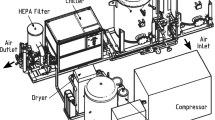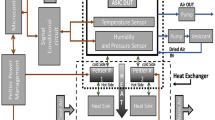Abstract
Purpose
In order to avoiding the potential radiation harm caused by X-ray tube to the crew, and meeting the testing requirements for WLSF pad of Calorimeter Cell in the High Energy cosmic-Radiation Detection facility (HERD).
Method
Designed a testing system, which is composed by LED, LYSO crystal, and narrow bandpass filter. The stability of the testing system is validated by conducting long-term measurements of signal amplitudes using a PMT waveform sampling module.
Results and conclusions
The result showed that the deviation levels of the WLSF Pad’s light output test results are all less than 5%. The linear relationship between the results of testing system and the results obtained with the cosmic ray test has demonstrated the effectiveness of the testing system, which promises the further application in large-scale WLSF pads performance testing.















Similar content being viewed by others
References
P.W. Cattaneo, The space station based detector HERD: precise high energy cosmic rays physics and multimessenger astronomy. Nucl. Part. Phys. Proc. 306–308, 85–91 (2019). https://doi.org/10.1016/j.nuclphysbps.2019.07.013
C. Perrina, Attaining the PeV frontier of the cosmic ray spectrum in space with HERD, in EPJ Web of Conferences, vol. 280 (2023), p. 01008. https://doi.org/10.1051/epjconf/202328001008
N. Mori, HERD Collaboration et al., The high energy cosmic-radiation detection (HERD) facility for direct cosmic-ray measurements, in 41st International Conference on High Energy physics, (2023). https://doi.org/10.22323/1.414.0123
B. Hu, X. Gao, L. Wang et al., Research on ICCD for space observation of cosmic ray and dark matter, in Space Telescopes & Instrumentation: Ultraviolet to Gamma Ray. International Society for Optics and Photonics, (2014). https://doi.org/10.1117/12.2055690
E. Berti, A. Tiberio et al., Design and implementation of the double read-out system for the calorimeter of the HERD experiment. J. Phys. Conf. Ser. 2374, 012047 (2022). https://doi.org/10.1088/1742-6596/2374/1/012047
P. Betti, O. Adriani, M. Antonelli, Y. Bai, X. Bai, T. Bao, E. Berti, L. Bonechi, M. Bongi, V. Bonvicini et al., Photodiode read-out system for the calorimeter of the herd experiment. Instruments 6, 33 (2022). https://doi.org/10.3390/instruments6030033
G.V. Ioannis et al., Evaluation of the light emission efficiency of LYSO: Ce scintillator under X-ray excitation for possible applications in medical imaging. Nucl. Instrum. Methods Phys. Res. (2006). https://doi.org/10.1016/j.nima.2006.08.018
Y. Dai, X. Cui, X. Liu et al., Study on temperature response of the HERD calorimeter cell. Radiat. Detect. Technol. Methods 7, 227–233 (2023). https://doi.org/10.1007/s41605-022-00377-7
F. He, V. Jary et al., Temperature dependence of luminescence characteristics of Lu2(1-x)Y2xSiO5:Ce3+ scintillator grown by the Czochralski method. J. Appl. Phys. 108, 033519 (2010). https://doi.org/10.1063/1.3457856
A.F. Martins et al., Spectroscopic analysis of LYSO: Ce crystals. Spectrochim Acta Part A 172, 163–167 (2017). https://doi.org/10.1016/j.saa.2016.04.019
W.M. Yao et al., Review of particle physics. J. Phys. G Nucl. Phys. 33, 245–251 (2006). https://doi.org/10.1088/09543899/33/1/001
T. Coan, T. Liu, J. Ye, A compact apparatus for muon life time measurement and time dilation demonstration in the undergraduate laboratory. Am. J. Phys. 74, 161–164 (2006). https://doi.org/10.1119/1.2135319
Acknowledgements
Thank the support from the National Natural Science Foundation of China (Grant No. 12027803, 11875097, 11975257) and the support from the International Partnership Program of Chinese Academy of Sciences (Grant No. 113111KYSB20190020). This work was supported by the National Natural Science Foundation of China (No. 12074045 and 62027820), the Natural Science Foundation of Jilin Province (No. 20210101408JC, 20230101352JC), and “111” Project of China (D17017).
Author information
Authors and Affiliations
Corresponding authors
Ethics declarations
Conflict of interest
The authors declare that they have no conflict of interest.
Rights and permissions
Springer Nature or its licensor (e.g. a society or other partner) holds exclusive rights to this article under a publishing agreement with the author(s) or other rightsholder(s); author self-archiving of the accepted manuscript version of this article is solely governed by the terms of such publishing agreement and applicable law.
About this article
Cite this article
Duan, W., Cui, X., Liu, X. et al. Test system designed for WLSF pads of HERD calorimeter cell. Radiat Detect Technol Methods (2024). https://doi.org/10.1007/s41605-024-00456-x
Received:
Revised:
Accepted:
Published:
DOI: https://doi.org/10.1007/s41605-024-00456-x




